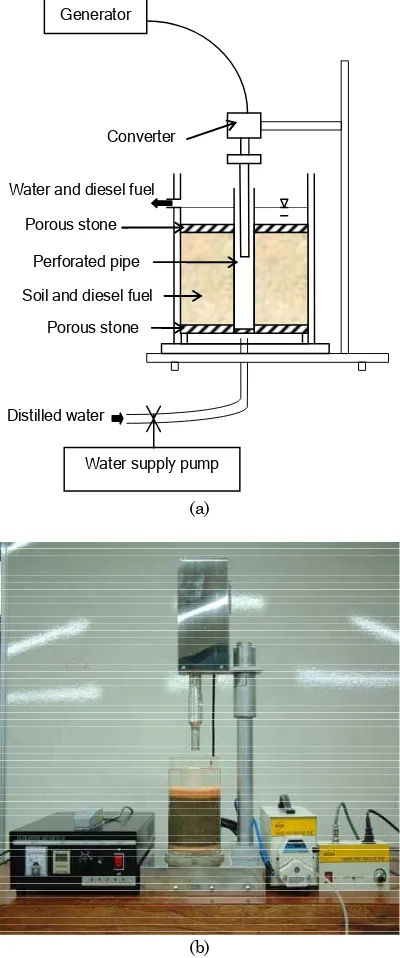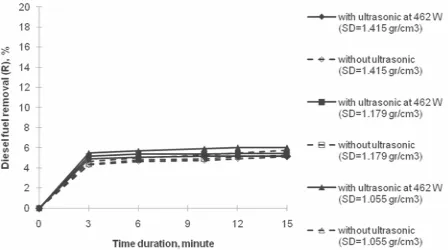Technical Note:
Remediation of Diesel Fuel Contaminated Sandy Soil using
Ultrasonic Waves
Wulandari, P.S. 1)
Note from the Editor
Ultrasonic cleaning has been used in industry for some time, but the application of ultrasonic cleaning in contaminated soil is just recently received considerable attention, it is a very new technique, especially in Indonesia. An ultrasonic cleaner works mostly by energy released from the collapse of millions of microscopic cavitations near the dirty surface. This paper investigates the use of ultrasonic wave to enhance remediation of diesel fuel contaminated sandy soil considering the ultrasonic power, soil particle size, soil density, water flow rate, and duration of ultrasonic waves application.
Keywords
:
diesel-fuel, remediation, sandy soil contamination, ultrasonic waves.Introduction
A considerable amount of diesel fuel may spills on the ground due to possible leakage of diesel fuel from underground storage tanks, gas stations, or military facilities. The pollutant should be cleaned in time to prevent it penetrating further into soils and ground water. In recent years, the use of ultrasonic waves to remedy the contaminated soils has received considerable attention. The ultrasonic cleaning principle is based on the fact that solid materials are good conductors of sound waves. Generation of ultrasonic waves has several mechanical, chemical, and biological effects on the medium. Ultrasonic treatment involves changing the surface of soil particles in contaminated soils by the application of ultrasonic principle, thereby removing contaminants [1]. Most of the investigations found that ultrasonic principle was able to enhance the remediation of contaminated soils. Feng and Aldrich [2] reported that contaminant extraction using ultrasonic is influenced by the ultrasonic power intensity, duration, and particle size of the soil. Their investigation revealed that; (a) diesel removal increased with the increase in the power intensity, (b) prolonged ultrasonic irradiation could not increase the efficiency of diesel fuel removal, and (c) diesel fuel was more easily removed from relatively coarse particles.
1 Dept. of Civil Engineering, Petra Christian University, Surabaya, Indonesia.
Email: [email protected]
Note: Discussion is expected before November, 1st 2010, and will be
published in the “Civil Engineering Dimension” volume 13, number 1, March 2011.
Received 11 May 2009; revised 17 April 2010; accepted 7 July 2010.
Kim et al’s [3] test results indicated sonication can enhance pollutant removal considerably and the degree of enhancement depends on ultrasonic power, soil type, and soil density. Increasing power increased pollutant extraction, while the faster the flow rate was, the smaller the degree of enhancement would be. It was also reported that the pollutants in dense soil were more difficult to be removed than in loose soil. Kim and Wang [4] concluded that the rate of contaminant extraction increased considerably with increasing ultrasonic power up to the level where cavitations occurred. Newman et al. [5] also reported that ultrasonic waves could improve the removal of copper oxide from soil.
The purpose of this test is to investigate the enhancement of remediation of diesel fuel contaminated sandy soil using ultrasonic waves considering the ultrasonic power, soil particle size, soil density, water flow rate, and duration of ultrasonic waves application. These tests were all conducted on soil samples in ultrasonic chambers.
Experimental Works
Experimental setup
A series of laboratory experiments were conducted using testing apparatus as shown in Figure 1. It was composed of two parts, ultrasonic processor and Plexiglas cylindrical chamber.
kHz. The generator converted main voltage to high frequency of 20 kHz. The tip of ultrasonic horn was one inch in diameter. It generated sound waves, which induced cavitations.
Water and diesel fuel Generator
Soil and diesel fuel
Porous stone
Distilled water
Water supply pump Converter
Perforated pipe Porous stone
(a)
(b)
Figure 1. Schematic (a) and the photograph (b) of testing apparatus
The Plexiglas cylinder chamber was 15 cm in diameter and 20 cm in height. The bottom of the cylinder was provided with an inlet for flowing water from the water reservoir to the soil sample, which was placed in the cylinder. The mixtures of sandy soils and diesel fuel with 10% concentration by soil volume were prepared in the testing chamber at determined density. Those test soil had a diameter of 15 cm and a height of 10 cm.
As expressed in Equation 1, initial diesel fuel concentration in the test soil, Co, were determined in
volume,
The physical properties of test soil are shown in the Table 1. The dry sandy soil was given an initial water content of 12% prior to mixing with the diesel fuel.
Table 1. Physical properties of test soils and contaminant
Parameter Value Specific gravity (Gs) 2.64
Uniformity coefficient (Cu) 2.68 Effective grain size (D10), mm 0.25
Unified soil classification SP Density of diesel fuel, g/mL 0.8074
The diesel fuel used in the experiments was obtained from a gas station. Distilled water was used in all the experiments.
Test Procedures
In this study, the soil flushing tests were conducted for two conditions, without ultrasonic waves and with ultrasonic waves at 20 kHz frequency. Experimental parameters and testing condition are summarized in Table 2.
Table 2. Parameter and testing condition of experiments
Parameter and testing condition Value Frequency of ultrasonic wave (kHz) 20
Power of ultrasonic (Watt) 462 ; 528 ; 616
Particle size of test soil (mm) 0.425-0.85 ; 0.25-0.425 ; 0.15-0.25 Test soil density (g/cm3) 1.415 ; 1.179 ; 1.055 Duration of soil treatment (min) 3 ; 6 ; 10 ; 12 ; 15 Water flow rate (cm/sec) 4.5 ; 14.5 ; 23.5
ultrasonic horn against direct contact with the specimen in test chamber. The ultrasonic horn was subjected to ultrasonic waves at 20 kHz frequencies in the variations of ultrasonic power of 462, 528, and 616 Watt. While the ultrasonic treatment proceeded, the distilled water was allowed to flow through the test soil. The variations of water flow rate were 4.5, 14.5, and 23.5 cm/sec. The experiments were held for the duration of 3, 6, 10, 12, and 15 minutes.
The effluent was collected in a 500 ml glass cylinder and the volumes of diesel fuel removal were then measured. The effluent of soil treatment without ultrasonic was allowed to stand overnight for gravitational segregation of water and diesel fuel. The volumes of the separated diesel fuel were then measured. The effluent of soil treatment with ultrasonic needed longer time for gravitational segregation of water and diesel fuel, thus for practical reason, the amount of extracted diesel fuel with ultrasonic treatment was determined by gas chromatography test. Before the gas chromatography test, the effluent was stirred about 30 second using magnetic stirring to make a homogeneous solution. Sample of effluent was taken during the stirring.
Results and Discussion
The major factors that may influence the effect of ultrasonic enhancement on diesel fuel removal were investigated through a series of laboratory testing.
The percentage of diesel fuel removal, R, were calculated by the following equation,
%
100
x
V
V
R
co cr
=
(3)where Vcr is the volume of diesel fuel extraction and
Vco is the initial volume of diesel fuel in the test soil.
The effect of the duration of ultrasonic treatment is shown in Figures 2, 3, and 4 for particle sizes 0.425-0.85, 0.25-0.425, and 0.15-0.25 mm respectively. The percentage of diesel fuel removal is plotted against duration of soil flushing for both without and with ultrasonic power at 462 W for all range of soil density (SD).
In the initial stage of process, the rate of diesel fuel removal is high because the diesel fuel was bonded around the surface of the particles, thus can be extracted easier. During the ultrasonic treatment, diesel fuels are desorbed from the particle surfaces and diesel fuel-water emulsions are generated.
The effect of the soil particle size is shown in Figure 5. The ranges of soil particle sizes are 0.15~0.25,
0.25~0.425, and 0.425~0.85 mm. The contaminated soils were flushed for the duration of 10 minutes, without and with ultrasonic waves at 462 Watt. The results form experiments with three particles size ranges shows that the diesel fuel removal increased with the larger particle sizes. The finer particles had larger surface areas per unit mass and thus more adsorption surfaces were available for bonding of the diesel fuel.
Figure 2. Duration vs. diesel-fuel removal for range particle size of 0.425-0.85 mm
Figure 3. Duration vs. diesel-fuel removal for particle size of 0.25-0.425 mm
Figure 4. Duration vs. diesel-fuel removal for particle size of 0.15-0.25 mm
Figure 5. Soil particle size vs. diesel-fuel removal
Figure 6. Relation between soil density and diesel-fuel removal
The contaminated soils were treated with different ultrasonic power, as shown in Figure 7. The ultrasonic treatments for particle size in range 0.15~0.25, 0.25~0.425, and 0.425~0.85 mm in various soil density (SD) during 10 minutes showed increasing of diesel fuel removal with the increase in ultrasonic power and followed by a gradual decreased after a certain point. The drop in diesel fuel removal beyond 528 W can be caused by the cavitations effect. When cavitations occur, the swarm of minute air bubbles may impede upward diesel fuel flowing thus diesel fuel removal dropped.
Figure 7. Ultrasonic power vs. diesel-fuel removal
The effect of water flow rate in soil flushing during 10 minutes is shown in Figure 8. The variations of
water flow rate are 4.5, 14.5, and 23.6 cm/sec. The faster water flow rate decreased diesel fuel removal. The reason of this fact is slower water flow has longer time to interact with contaminated soil, so that the slower water flow is more efficient to remove diesel fuel than the faster one.
Figure 8. Water flow rate vs. diesel-fuel removal
Figure 9. Diesel fuel removal efficiency at ultrasonic power 462 Watt
Figure 9 shows that the applications of ultrasonic waves are more efficient in the larger particle size of soil. The diesel fuel removal efficiency of using ultrasonic treatment, Ecr, were calculated as shown
in Equation 4,
%
100
x
R
R
R
E
f f u cr
−
=
(4)where Ru is the percentage of diesel fuel extraction
by ultrasonic treatment and Rf is the percentage of
diesel fuel extraction by flushing only. The removal efficiency in the early time of soil flushing were significantly high, but the values decreased as the time elapsed.
Conclusions
significantly affected by soil particle size rather than other factors. For the same density of soil column, during 10 minutes of soil treatment, the range of soil particle size of 0.425~0.85 mm has the ultrasonic enhancement rate around 21% compared to around 9% for the range of soil particle size of 0.15~0.25 mm, thus, the larger the soil particles, the more effective the process of removing the diesel fuel. The efficiency of diesel fuel removal dropped beyond 528 Watt of ultrasonic power, thus, there is no need to increase the power of ultrasonic beyond 528 Watt.
References
1. Ensminger, D., Ultrasonics Fundamentals,
Tech-nology, and Applications, Marcel Dekker, Inc.,
New York, 1988.
2. Feng, D. and Aldrich, C., Sonochemical Treatment of Simulated Soil Contaminated with Diesel,
Advances in Enviromental Research, Elsevier,
2000, pp. 103-112.
3. Kim, Y. U., Kim, J. Y., Lee, I. M., Sonication Effect on NAPL Extraction from Soils, Journal of
the Korean Geotechnical Society, Vol. 16 No. 3,
2000, pp. 23-28.
4. Kim, Y. U., Wang, M. C., Effect of Ultrasound on Oil Removal from Soils, Ultrasonics, Elsevier, 2003, pp. 539-542.

